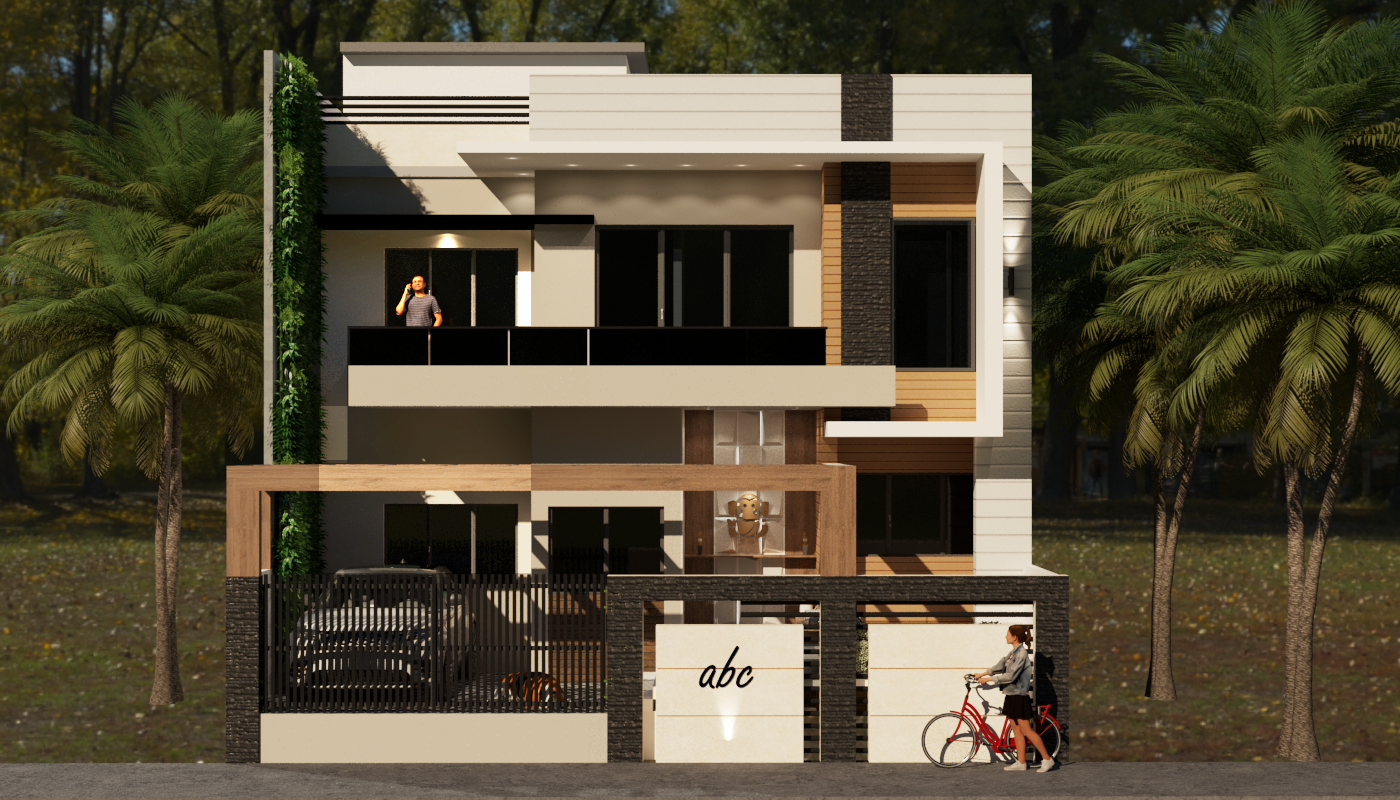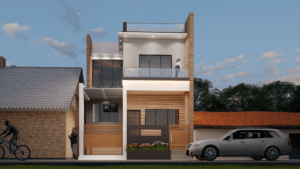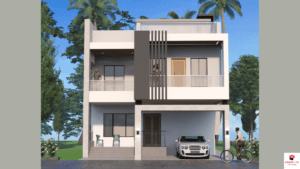Having a car is a necessity today, but for small homes, finding the right parking space can be a challenge. Limited area often leaves homeowners wondering Where do I park my car without blocking the house entrance or reducing living space?
The good news is, with a little creativity and planning, you can make room for your car even in compact spaces. Let’s explore some unique and practical car parking ideas for small homes.
Table of Contents
Toggle1. Front Yard Parking with Paver Tiles
Many homeowners turn a part of their front yard into a neat and functional car parking area. Using interlocking paver tiles or concrete blocks makes it both durable and attractive.
-
How to do it: Remove the top layer of soil, prepare a solid gravel/sand base, and lay pavers with proper edging to hold them in place.
-
Pros: Looks modern, requires low maintenance, and allows water drainage if done properly.
-
Cons: Reduces the greenery of your yard unless you leave planting strips.
-
Tip: Go for textured pavers to avoid slipping and include a narrow planter strip to maintain a touch of greenery.
2. Covered Carport
A carport is an open structure with just a roof, offering basic protection without the expense of a full garage.
-
How to do it: Fix posts and cover the area with a lightweight roof material like polycarbonate sheets, tin, or wood.
-
Pros: Protects from harsh sunlight and rain while being budget-friendly.
-
Cons: Doesn’t provide full security compared to an enclosed garage.
-
Tip: Add side slats or panels for more privacy while keeping airflow intact.
3. Sliding Gate Parking
Traditional swing gates require extra space to open and close. A sliding gate makes small driveways more efficient.
-
How to do it: Install a track-based or trackless (cantilever) sliding system along the boundary. You can even automate it for convenience.
-
Pros: Saves space, ideal for homes on narrow roads, and safer for vehicles.
-
Cons: More expensive than swing gates and requires regular track maintenance.
-
Tip: Opt for remote-controlled automation if your parking is tight and you want easy access.
4. Foldable Car Shed
If you don’t want to invest in a permanent structure, a foldable shed or pop-up garage is a flexible solution.
-
How to do it: Buy a portable car shed, set it up with a steel frame, and secure it to the ground with anchors. Use a waterproof, UV-resistant cover.
-
Pros: Affordable, movable, and great for renters or temporary parking.
-
Cons: Less durable, not as strong as permanent carports, and needs extra care during heavy winds.
-
Tip: Invest in a reinforced steel frame version for longer life and better protection.
5. Pergola Parking with Plants
If you want your car parking to look stylish, try a pergola with plants. It combines function with greenery.
-
How to do it: Build a pergola from wood or metal and let climbers or vines grow over it. Add trellises or planters for quick coverage.
-
Pros: Offers natural shade, keeps the area cool, and adds beauty.
-
Cons: Plants need care and won’t provide complete protection during heavy rain.
-
Tip: Choose fast-growing, low-maintenance climbers such as bougainvillea or money plant.
6. Stilt Parking (House on Pillars)
In urban plots, houses are sometimes built on pillars with open ground-floor parking. This is called stilt parking.
-
How to do it: Design your house with the ground floor left open for vehicles, while living spaces start from the first floor.
-
Pros: Maximizes use of vertical space and keeps your car safe under the structure.
-
Cons: Needs to be planned during construction and costs more than normal layouts.
-
Tip: Ensure the pillars are well-coated with anti-rust paint and the flooring has good drainage.
7. Mechanical Stack Parking
For families with two or more cars but only one parking bay, mechanical stack systems can help.
-
How to do it: Install a hydraulic lift that raises one car so another can be parked below it.
-
Pros: Doubles your parking space in the same footprint.
-
Cons: Expensive, requires electricity, and regular servicing.
-
Tip: Ideal for compact urban plots with limited land but multiple vehicles.
8. Side Driveway Parking
If your plot has a bit of extra width, consider a side driveway for parking.
-
How to do it: Pave the side strip with tiles or concrete and extend it to the back or side of the house.
-
Pros: Keeps the front entrance neat and provides direct car access.
-
Cons: Requires enough side clearance, which not all small homes have.
-
Tip: Add grass pavers to keep the natural green look intact.
9. Basement Parking
A basement garage can free up ground-level space for garden or living areas while keeping your car safe below.
-
How to do it: Requires excavation, retaining walls, a ramp, drainage pumps, and ventilation. Best to plan during house construction.
-
Pros: Secure, hidden from view, and saves above-ground space.
-
Cons: Costly, not suitable in high water-table areas, and needs waterproofing.
-
Tip: Use anti-skid materials for the ramp and install a sump pump to prevent waterlogging.
10. Multi-Purpose Parking Area
Why waste space on just parking? Make your parking bay double up as a social or functional area.
-
How to do it: Lay durable pavers or concrete, use retractable shades, and keep foldable furniture handy.
-
Pros: Perfect for small homes that need outdoor gathering space when the car is not parked.
-
Cons: Requires quick shifting of furniture whenever the car needs to be parked.
-
Tip: Use foldable or wheeled chairs and tables for easy movement.
11. Rooftop Parking (For New Constructions)
What it is: Using the flat roof of a house or podium as a parking area.
How to do it:
-
Design the structure strong enough to bear the weight of vehicles.
-
Build a ramp or install a car lift to access the rooftop.
-
Add guard rails for safety and proper drainage to avoid water pooling.
Pros: Saves precious ground space, adds security, ideal for tight urban plots.
Cons: Expensive, needs engineering expertise, not possible in all homes.
Tip: Plan this only during construction, not later. Use anti-slip tiles to prevent skidding.
12. Green Driveway Parking (Grass Pavers)
What it is: A driveway that looks like a lawn but can hold a car, thanks to permeable grass pavers.
How to do it:
-
Lay reinforced permeable paver blocks over compacted soil.
-
Fill gaps with soil and hardy turf grass.
-
Ensure proper drainage to prevent mud patches.
Pros: Eco-friendly, reduces heat, and keeps greenery intact.
Cons: Needs regular mowing and maintenance. Weak base can cause sinking.
Tip: Choose drought-tolerant grasses for less upkeep and longer durability.
13. Portable Car Covers
What it is: Weather-resistant covers or shells that shield the car when parked outdoors.
How to do it:
-
Buy a heavy-duty, waterproof, and breathable car cover.
-
Secure it with straps or anchors to avoid blowing away in strong winds.
Pros: Budget-friendly, easy to use, flexible.
Cons: Doesn’t protect from theft or extreme weather. Can cause scratches if dust gets trapped underneath.
Tip: Wash your car before covering to avoid micro-scratches from dust friction.
14. Compact Car Garage
What it is: A small enclosed garage designed specifically for one car.
How to do it:
-
Construct a snug garage with space-saving doors (sliding or roller).
-
Use vertical storage racks and overhead shelves for tools.
Pros: Secure, protects against weather, adds storage space.
Cons: Costs more than a carport, reduces open yard space.
Tip: Choose modular racks and wall-mounted storage to keep the garage clutter-free.
15. Corner Parking Space (Angled Parking)
What it is: A 45° angled parking arrangement in unused corners of the plot.
How to do it:
-
Pave the corner and design the entry to allow smooth angled parking.
-
Add painted markings or tiles for easy alignment.
Pros: Perfect for odd-shaped plots, easier maneuvering.
Cons: May waste space compared to straight parking.
Tip: Mark guiding lines on the ground so you don’t misalign the car in tight corners.
16. Parking with Storage on Top (Lofted Storage)
What it is: A parking space with an overhead loft or mezzanine for extra storage.
How to do it:
-
Construct a structurally safe loft above the car’s height.
-
Store seasonal or light items on the platform.
Pros: Doubles up the utility of parking, reduces clutter indoors.
Cons: Not suitable for tall SUVs; requires proper engineering.
Tip: Use foldable stairs or ladders for safe access to the loft.
17. Vertical Garden + Parking Combo
What it is: A shaded car parking spot with a green wall or vertical planter beside it.
How to do it:
-
Build a trellis or modular vertical garden frame near the parking bay.
-
Use a drip irrigation system for easy maintenance.
Pros: Beautifies parking area, reduces heat, improves air quality.
Cons: Needs watering and upkeep; some plants may attract insects.
Tip: Use hardy, low-maintenance plants like money plant, jade, or succulents.
18. Shared Driveway Parking (with Neighbor)
What it is: Sharing a common driveway or parking strip with an adjacent house.
How to do it:
-
Create a mutual understanding or legal agreement.
-
Pave the driveway jointly and share costs of shade or gates.
Pros: Saves land and construction costs, practical in urban colonies.
Cons: Requires good coordination, possible conflicts.
Tip: Draft a simple written agreement for peace of mind.
19. Smart Rotating Platform (Turntable)
What it is: A motorized turntable that rotates the car, so you don’t need to reverse.
How to do it:
-
Install a rotating platform at driveway level.
-
Connect it to an electric motor with safety features.
Pros: Saves space, very handy in narrow streets, looks modern.
Cons: Expensive, requires electricity and servicing.
Tip: Perfect for homes in crowded lanes where maneuvering is tough.
20. Parking Under Balcony Extension
What it is: Using the covered space beneath a projecting balcony as a car parking bay.
How to do it:
-
Design the balcony extension with enough clearance (at least 7–8 feet).
-
Waterproof the slab and install drainage pipes to avoid dripping on the car.
Pros: Cost-effective, provides natural shade, saves space.
Cons: Limited height, water seepage risk.
Tip: Add a gutter system on the balcony edge to divert rainwater safely.
Final Practical Tips (Quick Checklist)
-
Measure carefully: Ensure your chosen idea fits the car’s dimensions and allows opening doors comfortably.
-
Surface matters: Use proper base layers (compacted gravel/sand) for any paved parking to prevent sinking.
-
Drainage: Sloped surface or proper drains prevent water pooling and damage.
-
Security: If security is a concern, prefer enclosed garages, gates, or CCTV.
-
Local rules: Check local building codes and neighborhood rules before major changes.
-
Maintenance: Consider upkeep green drives and pergolas need care; mechanical systems need service.
Conclusion
Finding the right car parking solution for a small home doesn’t have to be difficult. With smart planning, you can turn even the tightest spaces into functional, safe, and stylish parking areas. Whether it’s a simple option like paver tiles and portable sheds, or advanced solutions like mechanical stack parking and rotating platforms, the key is to balance space, budget, and convenience. By choosing the right idea for your plot size and lifestyle, you can keep your car protected while maintaining the beauty and utility of your home.
Design Smarter Homes with SmartScale
At SmartScale House Design, we specialize in creating modern, space-saving, and Vastu-friendly house plans that make the best use of every inch including smart parking solutions. If you’re planning to build or redesign your home, let us help you design a house that’s practical, stylish, and future-ready.
👉 Contact SmartScale today and let’s plan your dream home together!








